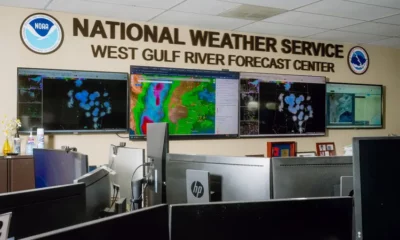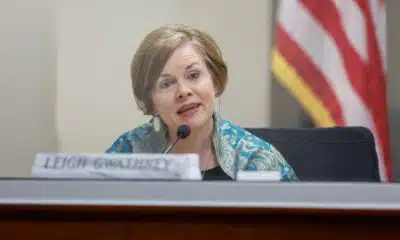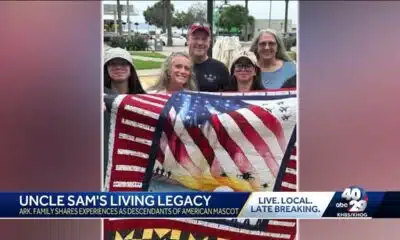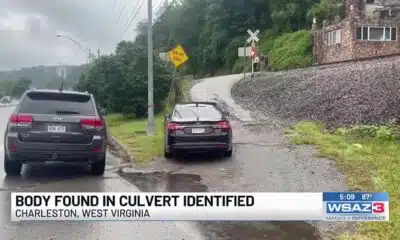News from the South - Texas News Feed
Cornyn won’t support a spending bill without $11 billion for Texas
‘
“John Cornyn says tax and spending bill must reimburse Texas $11 billion for border security” was first published by The Texas Tribune, a nonprofit, nonpartisan media organization that informs Texans — and engages with them — about public policy, politics, government and statewide issues.
Sign up for The Brief, The Texas Tribune’s daily newsletter that keeps readers up to speed on the most essential Texas news.
Texas Republicans in Congress are ramping up their requests for the federal government to reimburse Texas for years of state spending on border security.
Sen. John Cornyn told The Texas Tribune that any amount less than $11.1 billion for Governor Greg Abbott’s “Operation Lone Star” would be “unacceptable.”
The Senator said he is not willing to vote for a spending package – also known as the budget reconciliation bill – that does not include reimbursement for Texas.
“I’ve seen some other numbers thrown around, but anything less than full compensation is unacceptable,” Cornyn said.
Abbott started Operation Lone Star in 2021 with a surge of state resources to the southern border as he accused the Biden administration of not doing enough to enforce immigration laws and prevent border crossings.
Since the start of the second Trump administration, Abbott and Texas Republicans in Congress have pressured President Donald Trump and congressional leaders to reimburse the state for its border security operation.
“We didn’t give it, we loaned it, they need to pay us back,” Rep. Roger Williams, R-Willow Park, told The Tribune. “We did everything the federal government should have done, so we need to get the money.”
Multiple members said they are cautiously optimistic that reimbursement would be included in the budget reconciliation package, which is currently being drafted in the House of Representatives. The package will be a large collection of bills related to federal spending and taxes created to match the budget outline Congress passed last month, which promised significant cuts.
Many of the 27 Texas Republicans in Congress have the ability to strongly influence the budgeting process. This includes Rep. Jodey Arrington, R-Lubbock, who chairs the House Budget Committee, which is tasked with combining the budget recommendations from House committees into one bill.
Arrington told The Tribune on Thursday that the amount that may be reimbursed to Texas is undetermined, but that the “commitment is there,” from Trump and Republican leadership to compensate the state.
“I just believe that when the ink is dry on the final product that that will be in the mix,” Arrington said.
Rep. Chip Roy, R-Austin, listed reimbursing Texas as one of his five reforms he wants included in budget reconciliation in a letter to House leadership. Roy, a member of the hard-right Freedom Caucus, has in the past held out on supporting major legislation — including last month’s budget vote — to persuade leadership to make promises or alter a bill.
Roy told The Tribune that reimbursing Texas is one of many items he is pushing for, and one that he believes will be included in the final bill.
“What was the benefit of joining the union if the union isn’t going to defend the country?” Roy said.
Roy, like many Republican members, has pushed for sharp cuts to federal spending. But the congressman doesn’t view reimbursing Texas for Operation Lone Star as contradictory to this wider goal.
“We already spent it when it was the federal government’s job,” Roy, a member of the House’s budget and judiciary committees, said.
Roy said his other reconciliation priorities include an overhaul of Medicaid, repealing the Inflation Reduction Act and extending Trump’s 2017 tax cuts. His main focus, he added, is making sure the “math adds up” in the final bill and he is hesitant to draw any red lines.
Within the Judiciary Committee’s budget recommendations is nearly $800 million set aside for the reimbursement for state and local participation in supporting immigration enforcement and decreasing criminal gangs, transnational criminal organizations and human trafficking. While Texas would have a claim to this reimbursement, the total amount is well below the $11 billion requested by Texas Republicans and would likely be split with other states.
Rep. Michael McCaul, R-Austin, is the vice-chair of the House Homeland Security Committee, which did not include refunding Texas in its portion of the budget bill. McCaul said more details need to be worked out regarding how to repay other states that funded border security efforts.
“Texas had to stand up and do the federal government’s job when they weren’t doing it,” McCaul said. “I think it’s very appropriate that we reimburse the state and the other states that helped out as well.”
McCaul said that he wants the reimbursement of Texas to be added to the final bill – adding that the state deserves the money.
“It’s probably one of those things you don’t want to call a lot of attention to,“ McCaul said in an interview. “Sometimes it’s better to put something in and not make a lot of fanfare about it until afterwards.”
House Speaker Mike Johnson, R-Louisiana, said this week that he wants the House to pass the package by Memorial Day.
First round of TribFest speakers announced! Pulitzer Prize-winning columnist Maureen Dowd; U.S. Rep. Tony Gonzales, R-San Antonio; Fort Worth Mayor Mattie Parker; U.S. Sen. Adam Schiff, D-California; and U.S. Rep. Jasmine Crockett, D-Dallas are taking the stage Nov. 13–15 in Austin. Get your tickets today!
This article originally appeared in The Texas Tribune at https://www.texastribune.org/2025/05/09/operation-lone-star-billions-reimbursement-john-cornyn/.
The Texas Tribune is a member-supported, nonpartisan newsroom informing and engaging Texans on state politics and policy. Learn more at texastribune.org.
The post Cornyn won’t support a spending bill without $11 billion for Texas appeared first on feeds.texastribune.org
Note: The following A.I. based commentary is not part of the original article, reproduced above, but is offered in the hopes that it will promote greater media literacy and critical thinking, by making any potential bias more visible to the reader –Staff Editor.
Political Bias Rating: Center-Right
The article discusses Texas Republicans’ push for federal reimbursement for the state’s border security spending, specifically in relation to Governor Greg Abbott’s “Operation Lone Star.” The tone of the article reflects the perspectives of Texas Republican officials, including Senators John Cornyn and members of the House of Representatives such as Chip Roy and Roger Williams, who emphasize the state’s role in border security and seek compensation from the federal government. The content’s focus on the Republican Party’s demands and framing of border security as a federal responsibility positions the article with a Center-Right lean, aligning with conservative political views on immigration and state rights.
News from the South - Texas News Feed
Warnings gave Kerr County officials hours to act before flood
“Weather warnings gave officials a 3 hour, 21 minute window to save lives in Kerr County. What happened then remains unclear.” was first published by The Texas Tribune, a nonprofit, nonpartisan media organization that informs Texans — and engages with them — about public policy, politics, government and statewide issues.
Sign up for The Brief, The Texas Tribune’s daily newsletter that keeps readers up to speed on the most essential Texas news.
Three hours and 21 minutes.
That’s how much time passed from when the National Weather Service sent out its first flash flood warning for part of Kerr County to when the first flooding reports came in from low-lying water crossings.
The weather service says that first warning triggered one of many automatic alerts to cell phones and weather radios, telling people in the area of the danger.
But if any local officials got those warnings, and if so, whether they activated in any meaningful way in that 3 hours and 21 minutes remains a black box.
County officials have not responded to requests for interviews and have not said at public press conferences what efforts they took when the flooding threat turned from possible to imminent in the middle of the night. At those press conferences, Kerrville’s city manager has repeatedly said they are focused on search and rescue, rather than answer questions about their response.
“We knew there was a flash flood warning,” Gov. Greg Abbott said at a press conference on Tuesday. “No one would know that would be a 30-foot-high tsunami-ball of water.”
NWS officials said they communicated directly with local officials during the night of the floods, but did not specify when. In some cases, they said, calls went to voicemail. Kerrville’s mayor said he was unaware of the flooding until around 5:30 a.m., more than four hours after that first warning, when the city manager called and woke him up.
Warnings didn’t go up on county Facebook pages until around the same time — when the Guadalupe River had already risen rapidly and pushed out of its banks around Hunt and was making its way toward the county seat of Kerrville.
Weather experts say that — from the outside at least — weather service forecasters appear to have done most everything right as the river rose with astonishing speed, blew past its previous record level and blasted through summer camps, RV parks, homes and campgrounds. It’s the kind of situation that meteorologists warn trainees about, the sort of nightmare scenario some refer to as a silent killer. A holiday weekend that brings out-of-town visitors to the area known as “Flash Flood Alley.”
The worst of the danger arrived in the dark, while people slept. The river claimed more than 90 lives in Kerr County, where many people were still missing more than four days later.
The weather service on Thursday afternoon put out a flood watch, which is a specific threat designation that means the conditions are present for a flood to happen.
“That far ahead of an event like this, that’s the most you can do,” said Bob Henson, a meteorologist and journalist with Yale Climate Connections.
And the agency issued increasingly urgent warnings through the night, which should have given most people enough time to escape death if they received and understood them, said Daniel Swain, a climate scientist with the University of California Agriculture and Natural Resources.
Questions remain about whether people along the river had cell service to get the push alerts, had alerts enabled on their phones, or were even awake to heed them.
Had they been warned of the coming flood, many people could have walked in the rainy darkness to higher ground.
“This really does appear to be a case where had there been even a modest acknowledgement of the level of danger that was predicted by the weather service, I don’t think much of the scope of loss of life would have happened,” Swain said in a public video call Monday.
Thursday afternoon: the first flood watch
Emergency officials across Central Texas had reasons to pay attention to the skies well before the deadly flooding occurred and the July 4 holiday weekend got into full swing. Federal forecasters issued a flood watch for a swath of the state at 1:18 p.m. Thursday, including for Kerr County, where at least 30 children would die. Nineteen other people have been confirmed dead in other counties from the widespread floods as of late Tuesday.
A flood watch is intended to indicate to local emergency officials and others that they should be on the lookout, weather experts said. Forecasts on Thursday didn’t say exactly where the worst rain might fall and how much — because that’s very difficult to predict so far ahead, meteorologists said. Where exactly the rain falls can make a big difference in river forecasting.
“I look at flash flood events like this very similarly to tornadoes,” said Alan Gerard, a retired NOAA meteorologist and current CEO of Balanced Weather. “We can tell you the conditions are favorable … but we can’t tell you exactly how strong the tornado is going to be and whether or not it’s going to hit your house.”
Kerr County is part of the Texas Hill Country, where the limestone hills lack deep layers of soil to absorb water. Rivers can rise shockingly fast. Deadly flood events have happened there repeatedly in the past.
The Texas Division of Emergency Management had activated rescue teams and bumped up its readiness level Thursday to bring more help on board. Lt. Gov. Dan Patrick said the regional director for TDEM personally called local officials to discuss the brewing storm. A state rescue task force, military vehicles and aircraft were stationed in the region, mostly in San Antonio, TDEM Chief Nim Kidd said during a press conference Friday night.
But whether Kerr County officials got a call or took any particular action after the July 3 flood watch went out is unclear. At a news conference on Friday as the death toll rose, Kerr County Judge Rob Kelly said, “We didn’t know this flood was coming.”
Neither Kelly, the county sheriff nor the emergency management coordinator responded to requests for interviews.
Part of the problem could be alert fatigue, especially in an area known for frequent flooding. People often receive multiple flood watches that don’t result in actual flooding, said Avantika Gori, an assistant professor of civil & environmental engineering at Rice University and flood risk expert. This can lead to complacency, with people thinking, “It’s just another one of those things,” she said.
They may also not understand the difference between a watch and warning, Gori said.
The first flash flood warning: Friday 1:14 a.m.
Kerrville Mayor Joe Herring, 63, who grew up in the city, recalled seeing reports Thursday night of a chance of rain around the time of the July 4 kids’ bike parade the next day. A friend warned him heavy rain was possible across a large area, but he didn’t feel worried.
“I went outside and looked at the clouds and thought someone is going to get rain, but it’s not going to be us,” he said. He said thunder woke him around midnight, and he was glad to see some rain falling. The Hill Country was in a significant drought.
More specific warnings, which indicate flooding is occurring or imminent, came later in the night as the forecast developed and data poured in. Extra people were on duty at the weather service office in New Braunfels, said Erica Cei, a weather service spokesperson.
At 1:14 a.m., the National Weather Service pushed out its first flash flood warning for central Kerr County, saying that data indicated life-threatening flash flooding was occurring or would begin soon. That message automatically triggered alerts to radios and cell phones, Cei said.
At that point, the river had barely started to rise.
The river was still within its banks in most places, and the incongruity between the warning and what people saw on the ground could potentially have caused people not to take action, Erik Nielsen, an instructional assistant professor at Texas A&M University, said in an email. It’s just one of many challenges of issuing effective warnings that are hard to overcome, he said.
People like Valerie Peters, who was staying at a Kerrville RV campsite called Jellystone Park, woke to the rainfall at some point and said she didn’t notice anything out of the ordinary. She said she looked at the emergency notifications, shut the sound off and she went back to bed.
She had been looking forward to a weekend of painting, karaoke and cornhole tournaments with her family. Luckily, her campsite avoided serious damage.
“We could have died,” Peters said. “We had no idea how serious this rain was.”
For officials in the early morning hours, there was still time to act as the rain pounded.
At 4:03 a.m., two hours and 49 minutes after their initial flood warning, federal forecasters warned that the rain had created a flash flood emergency for south-central Kerr County. Weather forecasters only use that term in what the agency says are “exceedingly rare” cases to indicate that lives are very much at risk.
“This is a PARTICULARLY DANGEROUS SITUATION. SEEK HIGHER GROUND NOW!” the warning said.
The Guadalupe River was rising precipitously. In the nearly three hours since the first warning went out, it had risen 14.3 feet, according to the river level gauge near Hunt, upriver from Kerrville. It would rise another 15.5 feet, according to the data, before the gauge broke.
At 4:35 a.m., three hours and 21 minutes after the first warning, the weather service office started to get reports from the Kerr County sheriff’s office of low-level flooding, Cei said. The river was still rising.
Forecasters pushed out a second flash flood emergency alert at 5:34 a.m., now for east central Kerr County, saying that “a large and deadly flood wave” was headed down the Guadalupe River.
Again, they urged people to get to higher ground immediately. They described the threat of damage as catastrophic.
That was about the time the Kerr County Sheriff’s Office took to Facebook to warn “DANGEROUS FLOODING NOW.” On its Facebook page, Kerr County also posted a warning around then that the river was flooding.
Kerrville’s city manager — who told reporters that he’d been jogging near the river at 3:30 a.m. and saw no signs of flooding — woke the mayor with a phone call around 5:30 a.m. and told him the downtown park where a lot of the July 4th events were planned was under water.
Herring said he threw on some clothes and went downtown.
He got an alert on his phone from the CodeRED system the county uses at 6 a.m., he said, indicating a flash flood alert or “something to that effect.“ Residents can enroll in the system to get alerts. He said it was the only weather alert he got that morning.
The “last mile” weather alert problem
Communicating these developing threats as forecasts become more clear is what meteorologists call a “last mile” problem — and it’s long plagued the field. Even as weather service forecasters are issuing warnings, they might have no idea who’s listening or monitoring the situation from the other side.
“The big question marks are, who was the National Weather Service able to reach in person and who was able to monitor the automated warnings that went out through cell phones, through email blasts and so forth at 1, 2, 3, 4 a.m.,” said Henson, the meteorologist with Yale Climate Connections. “And that just comes down to county, local, and even to individual entities like campgrounds.”
At National Weather Service weather forecast offices, it falls to the warning coordination meteorologist — in this case Paul Yura, who retired from a decades-long career in April, a few years earlier than he planned — to build relationships with local community members to prepare for events such as this.
The White House on Monday defended the forecasting agency in the face of questions about whether nationwide staffing cuts had impacted their work.
Two of Mayor Herring’s close friends — Jane Ragsdale, director of the Heart O’ The Hills camp and Dick Eastland, one of the owners of Camp Mystic — died in the flooding and their deaths have hit him hard. He felt sure both would have checked the weather.
“I wish to God there had been some way to warn them,” he said.
Terri Langford, Ayden Runnels, Jaden Edison and Alejandra Martinez contributed reporting.
Disclosure: Facebook, Rice University and Texas A&M University have been financial supporters of The Texas Tribune, a nonprofit, nonpartisan news organization that is funded in part by donations from members, foundations and corporate sponsors. Financial supporters play no role in the Tribune’s journalism. Find a complete list of them here.
Shape the future of Texas at the 15th annual Texas Tribune Festival, happening Nov. 13–15 in downtown Austin! We bring together Texas’ most inspiring thinkers, leaders and innovators to discuss the issues that matter to you. Get tickets now and join us this November.
TribFest 2025 is presented by JPMorganChase.
This article originally appeared in The Texas Tribune at https://www.texastribune.org/2025/07/08/texas-weather-service-warning-kerr-county/.
The Texas Tribune is a member-supported, nonpartisan newsroom informing and engaging Texans on state politics and policy. Learn more at texastribune.org.
The post Warnings gave Kerr County officials hours to act before flood appeared first on feeds.texastribune.org
Note: The following A.I. based commentary is not part of the original article, reproduced above, but is offered in the hopes that it will promote greater media literacy and critical thinking, by making any potential bias more visible to the reader –Staff Editor.
Political Bias Rating: Centrist
The content provides a detailed, fact-based report on the events surrounding a deadly flood in Kerr County, Texas. It presents statements from various officials across the political spectrum, including Texas Governor Greg Abbott and Lt. Gov. Dan Patrick, without undue criticism or praise. The article focuses on the timeline and effectiveness of warnings from the National Weather Service and local officials, relying heavily on expert opinions and factual accounts. There is no evident editorializing or partisan framing; rather, it emphasizes public safety and accountability in emergency responses. This approach aligns with a neutral, centrist stance aimed at informing readers rather than advancing a political agenda.
News from the South - Texas News Feed
Hope for Texas flood survivors dims as search continues
SUMMARY: Catastrophic flooding in Texas’s Hill Country has claimed over 100 lives, including at least 27 campers and counselors at Camp Mystic, an all-girls Christian summer camp. Search efforts continue amid improving weather, though hopes of finding survivors dim. The floodwaters surged along the Guadalupe River, sweeping away people and debris. Questions arise about local officials’ warnings ahead of the disaster, with some camps managing to move campers to safety while others were caught off guard. In Kerr County alone, 84 bodies have been recovered, including 28 children. Hundreds of volunteers and rescue teams work through challenging terrain to find the missing.
The post Hope for Texas flood survivors dims as search continues appeared first on www.kxan.com
News from the South - Texas News Feed
Inside Amazon Prime Day: how small businesses like Nodnal are thriving
SUMMARY: Amazon Prime Day, extended to four days this year, is driving huge sales, with a local Houston same-day delivery warehouse working nonstop to fulfill orders. About 60% of Amazon sales come from independent small and medium businesses, including Houston-based Valo. Founded in 2017 by Leali and Brandon, Valo offers eco-friendly, gender-neutral, 100% cotton baby bedding designed by Leali’s wife. Partnering with Amazon has allowed Valo to reach a wider customer base and offer fast shipping options they couldn’t manage alone. The soft quality of their products has impressed many, highlighting the success of small businesses on Amazon Prime Day.
Amazon Prime Day starts today, and 60% of sales come from independent businesses! Julissa Garza visits an Amazon fulfillment …
-
News from the South - Louisiana News Feed7 days ago
Attorneys who run public defender offices replaced amid contract turmoil
-
News from the South - Alabama News Feed7 days ago
Gov. Kay Ivey expected to name Alabama parole board pick in coming days
-
News from the South - Arkansas News Feed4 days ago
Real-life Uncle Sam's descendants live in Arkansas
-
News from the South - Kentucky News Feed6 days ago
Man arrested after alleged strangulation of adult and juvenile
-
News from the South - Kentucky News Feed7 days ago
In small-town Kentucky, finding ‘all the more reason to resist’
-
Mississippi News Video6 days ago
MHP holiday travel enforcement period begins
-
News from the South - Missouri News Feed6 days ago
Bank robbery suspect arrested in suburban home neighbors say they warned about
-
News from the South - West Virginia News Feed5 days ago
Body found in Culvert identified












































